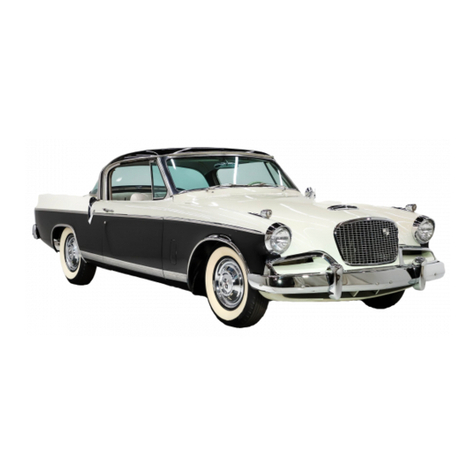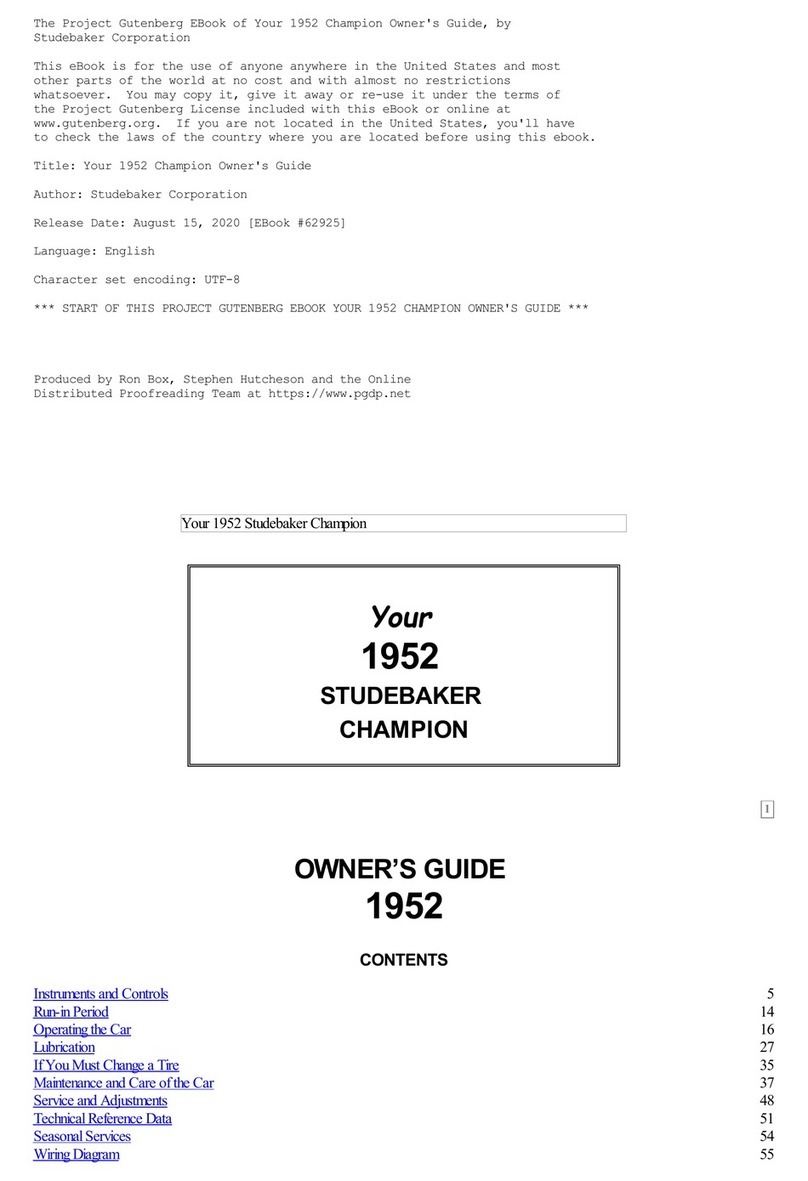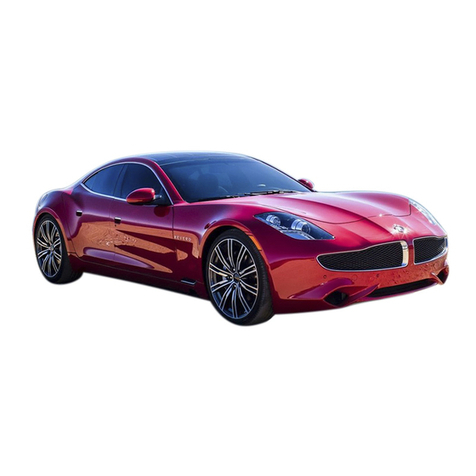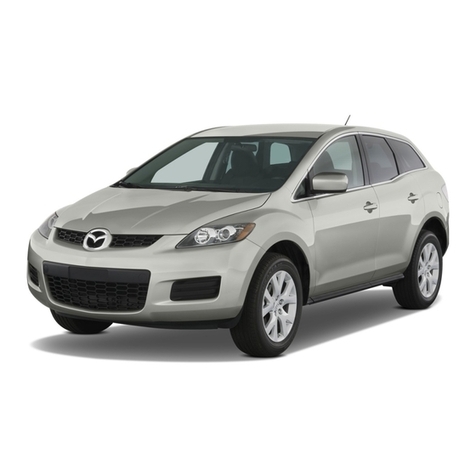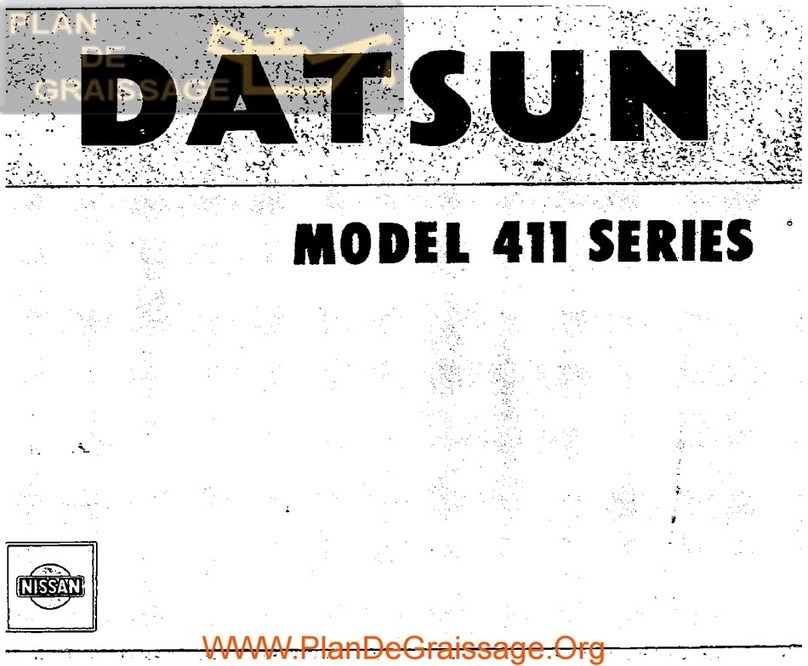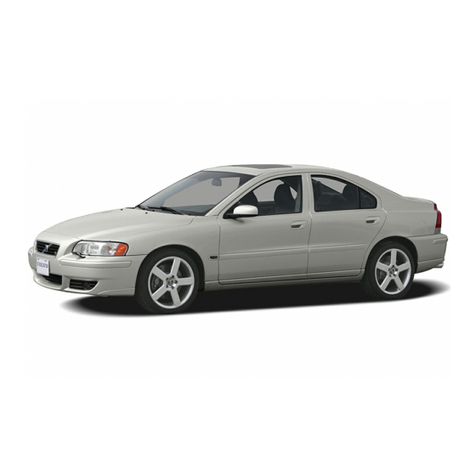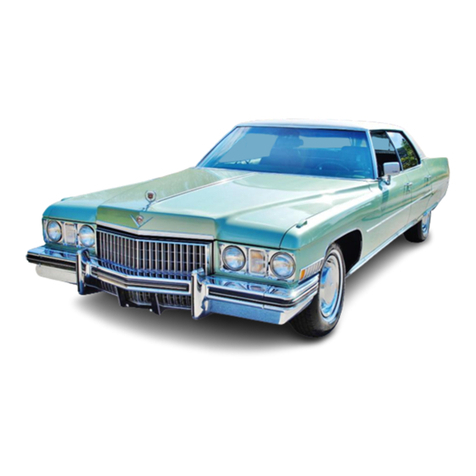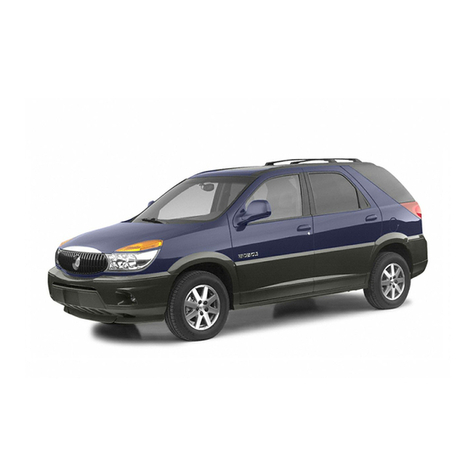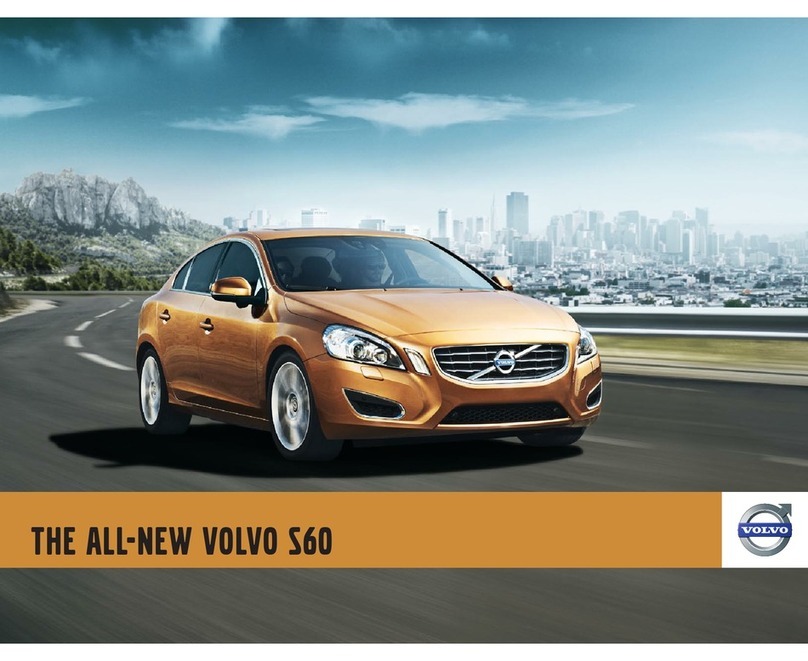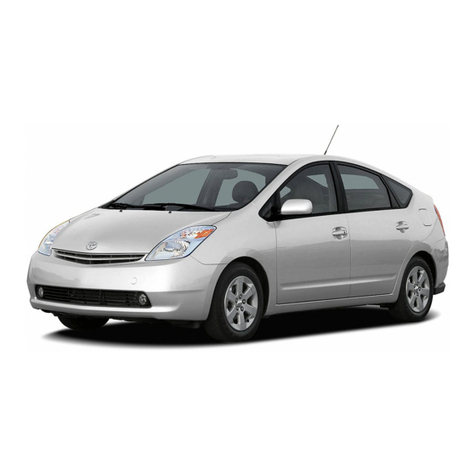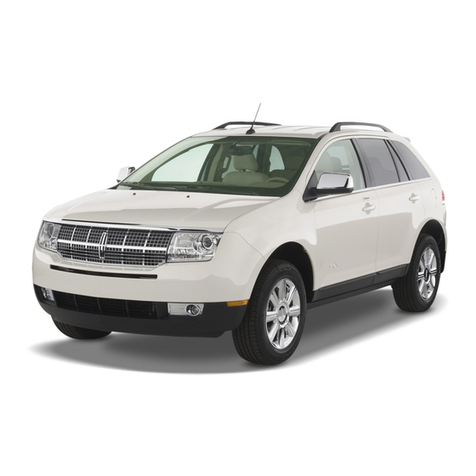Studebaker President Eight User manual

OWNER'S
MANUAL
Studebaker
President
Eight
131
and 121-inch
Wheelbase Models
THE STUDEBAKER CORPORATION OF
AMERICA
sotJT1-I
BEND,
INDIANA,

LICENSE DATA
Number of cylinders
Cylinder Bore
Stroke
Piston Displacement
3% inches
inchqs
336 cubic inches
Horse power (N. A. C. C. Rating)
Wheelbase 131 and 21
inches
Engine Number—On top surface of fan bracket boss.
Serial Number—on plate riveted to frame under left front
fender.
Body Number-—On plate attached to front of dash under
hood.
on the weight of any model
can be ob-
tained from the dealer.
The Use of This Book
For the convenience of the owner we have divided the book
into three sections, "Operation," "Care" and "Adjustments."
The first section, starting on page 5, contains
driving sug-
gestions and information on the instruments and controls.
This section of the book is of great importance and should
be thoroughly read by every owner no matter how experi-
enced
a motorist he may be.
The second section, starting on page 16,
carries instructions
on the lubrication and care of the car, including
many details
which will be of interest to every owner.
The third section, starting on page 35, covers in detail a
number of adjustment operations. To the car owner who
desires to take advantage of the facilities of a Studebaker-
Erskine Service Station, this section may not appeal and it
need not be read unless desired. The book should always
be kept in the car, however,
as this section may prove of
value, if at any time
when
touring, it is necessary
to go to a
garage not familiar
with the car. Luckily, with the fine net-
work of Studebaker-Erskine
dealers, this can seldom happen.
In this connection
should
be noted the advantages
of pre-
ventive maintenance. The experienced motorist will see the
folly of waiting until his car actually needs repairs before
go-
ing to his dealer. He will take his car periodically to a Stude-
baker-Er*kine
Service Station for inspection and adjustment
thus preventing the possibility
of serious difficulty resulting
from neglect. While this practice may seem extravagant on
the surface, it actually is economical. It is one of the best
kinds of insurance you can buy. The investment is small and
it keeps
your car working
at full efficiency.

Factory Warranty
E WARRANT each new motor vehicle sold by us,
whether passenger car or commercial
vehicle,
to be
free from defects in material and workmanship
under
normal use and service, our obligation under this warranty
being limited
to making good at Studebaker factories any part
or parts thereof which shall, within three months after delivery
of such vehicle to the original purchaser, be returned to us
with transportation charges prepaid, and which our examina-
tion shall disclose to our satisfaction to have been thus defec-
tive ; this warranty being expressly in lieu of all other warran-
ties and representations
express or implied and of all other
obligations
or liabilities on our part, and we neither assume
nor authorize any other person to assume
for us any other
liability in connection
with the sale or use of our motor
vehicles.
This warranty shall not apply
to any motor
vehicle
which
shall have been repaired or altered outside of Studebaker
fac-
tories in any way so as, in our judgment, to affect its stability
or reliability, nor which has been subject to misuse,
negligence
or accident; nor to any commercial
vehicle
sold by us which
shall have been operated at speed exceeding
the factory rated
speed, or loaded beyond the factory rated load capacity.
We make no warranty whatever in respect to tires, rims,
ignition apparatus, horns, or other signaling devices,
starting
devices, generators, batteries, speedometers
or other trade ac-
cessories, inasmuch as they are usually warranted separately
by their respective
manufacturers.
THE STUDEBAKER CORPORATION
OF AMERICA
SOUTH BEND, INDIANA

Service Agreement Between
Studebaker
Dealer and Purchaser
As Studebaker dealers we have assumed
the following
responsibilities
:
1. Within ninety days after the delivery of a new Stude-
baker or Erskine car to Purchaser we will install at our
Service Station, free of labor charges, any parts that the
Studebaker factories furnish free of cost to replace parts
found defective, in accord with the Factory Warranty
printed on Page 68. Purchaser will assume cost of parts
and installation of same pending
Factory decision.
Purchaser will
be notified
promptly
of the decision of Factory re-
garding
allowance
of claim
for replacement
or repair of parts re-
turned.
For service and replacements
on engine,
tires and rims, we will
furnish the address of the nearest service station maintained by
the manufacturer
of this equipment.
2. For thirty days following
the delivery of a new car to Pur-
chaser we will make free of charge inspections and adjust-
ments not necessitated by neglect or abuse. "Inspection"
includes examination and report as to the condition of
the car. "Adjustment" includes only such adjustments as
are necessary to put the car into good operating condition.
No responsibility is assumed for adjustments made in
service stations other than our own.
No promise of service, free repair work, inspection or adjustment ex-
cept as above specified, shall be binding on us.
When it is necessary, for the convenience of Purchaser, to render
service at a distance from our service station, the time spent by em-
ployees going to and from the job will be charged for at the regular rates
of the station, together with all proper expenses of making the trip,
cost of shipping
parts, if any, and other necessary incidental expense.
Any overtime, holiday,
or Sunday work done upon the request of Pur-
chaser will be charged for at the regular overtime rate.

Use Your Studebaker-Erskine Service Sta.
tion and Genuine Studebaker-Erskine
HE Studebaker Corporation
has spent a great deal of
time and energy in aiding its dealers to give efficient
and
satisfactory service
to the owner. A great many of our
dealers' mechanics have attended our service school at the
factory and all dealers are constantly aided by service
infor-
mation
sent out almost daily from the factory in the form
of
manuals,
bulletins and personal visits from our representa-
Our dealers have in stock genuine Studebaker-Erskine parts,
which
are approved
only after the vigorous tests of our lab.
Why should
you jeopardize
the life and efficiency
of your
car by having
your repair work done at other than an author
_
ized Studebaker-Erskine
Service Station? You would
knowingly
consent to the use of inferior parts in your car,
not
parts made to look like the genuine and which you are told
are the same
but which are made to sell at a price which
will
allow
the unauthorized garage, with their lack of service
tools
and factory aid and their inefficient
methods to make a profit.
Yet by patronizing them you-may be tacitly agreeing
to it.
Our factory
branches
are located
throughout
the country.
At each one of them is located a District Service
Manager
whose
duties are to keep in touch with the dealers in his terri-
tory, advising
and helping them with their service
problems.
While all matters concerning the operation of your car should
be taken up with the Studebaker-Erskine dealer from whom it
was purchased,
it may be you will sometime desire some
in-
formation
from the factory. In this case, learn from your
dealer the location of the branch under which he operates
and write to the District Service Manager at the address given
on page 53.
Lock Your Car
If your car is stolen
you may have to miss an appointment,
ride home
in a train or trolley, or give up that motor trip.
You will have to do without a car until the insurance company
settles,
the car is recovered
or until you can get delivery •of a
new car.
You may not lose a cent if the car is covered by insurance,
but there's the nuisance
of filling out insurance blanks, to say
nothing of loss' of time, temper, patience and possible damage
by a joy rider.
Locking is part of parking. BE SURE TO LOCK YOUR
CAR.
The greater
the number
of cars stolen the higher the insur-
ance
rate you pay.
Stealing of unlocked
cars is frequently but an incident
to
some
more serious or terrible crime. Why help the criminal?

Inspection and Adjustment at 500
Miles
HEN the new car has been driven five hundred miles,
or before
the end of the first month, it should be taken
to the service
station of your dealer for inspection
and
adjustment. The various parts of the car have then experi-
enced the period of initial service and it is important that the
car bc inspected and the necessary adjustments made at this
time. The car should be thoroughly examined including the
following items :
Adjustment of front wheel bearings.
Alignment of front wheels.
Adjustment of steering gear.
Examine for water, oil or gasoline leaks.
Adjustment of fan belt.
Adjustment of tappets.
Adjustment of carburetor.
Check engine to see if hitting properly.
Check ignition timing.
Check operation of oil filter.
Tighten cylinder head scre\vs.
Check engine oil pressure.
Check
generator charging rate.
Check clutch adjustment.
Examine for oil leaks at transmission and rear axle.
Adjustment of brakes.
"l'ighten all spring clips.
Tighten car all over.
Check for squeaks and rattles.
Mention any difficulty you may have concerning the car
when you take it in for this inspection and adjustment. There
will possibly be other details the dealer will desire to look
after at this time.
Do not delay in taking the car in after completing
the •first
five hundred miles. A minor adjustment neglected at this
time is likely to make necessary a Inore serious repair at some
future time.

OPERATION
Before Operating a New Car
The following instrutnents are shown in Illus. Nos. 1 to 3, pages 54
to 56.
Horn Button
The horn button is located at the center of the steering wheel. The
horn is operated by pushing down on this button.
Throttle Lever and Foot Accelerator
The throttle lever is at the upper right-hand s side of the center of the
steering wheel. It controls the engine speed and may be used to vary
the speed of the car. It is fully closed
when in the upward position.
The foot accelerator also controls the speed of the engine in a man-
ner similar to the throttle lever. Pushing on this with the foot increases
the engine
speed.
The foot accelerator
being returned by a spring to whatever position
is located by the throttle lever, makes a very flexible control for average
driving. On long stretches of country road, where the speed is fairly
constant, the throttle lever may be used.
Care must be' taken, in using these controls,
not to race the engine
when idle. Great harm can be done to an engine in this way, particu-
larly
if it is new
or cold.
Spark Lever
A spark lever is located at the upper left-hand side of the center of
the steering wheel. It is fully advanced
and in position for ordinary
driving when in its upward position. It may be retarded downward
for starting the engine or when the engine is pulling heavily at low
speeds.
Carburetor Dash Control
The carburetor dash control is a button on the instrument
board marked "C". It is used as an aid to starting and as such is indis-
pensable.
Read carefully the instructions on starting the engine on Page 13.
Intake Manifold Heat Control
A button located on the instrument board,
directly above the steering
column operates the manifold heat control valve. This button is marked
"H" and may be pulled out to open the valve and pushed in to close it.
The heat control valve should be open under all ordinary driving con-
ditions. Only in extremely hot weather or continuous
driving at high
speed should this valve be closed.
Ignition Switch
See "Steering Gear Lock" on page 7.
5

6OPERATION
Lighting Switch Lever
The lighting switch lever is located at the lower center of the steering
wheel and controls the lights. Several positions of this lever are pos-
sible, giving different combinations of lamps and dimming, which are
all marked on the dial at the center of the steering wheel.
Clock (131-inch wheelbase model).
A high-grade, stem-wound, stem-set clock is mounted in the instru-
ment panel. Do not wait until it is completely
run down to rewind it,
and do not wind it too tight.
Ammeter
This instrument indicates in amperes the current passing to or from
the battery. The pointer resting on the scale marked "Charge" indi-
cates that the generator is charging the battery. The pointer
resting on
the scale marked "Discharge" indicates that the battery is discharging.
With all lights off,
the ammeter should read "Charge" at speeds
above
ten miles per hour. If it does not, refer the matter to a Studebaker-
Erskine dealer.
Engine Oil Pressure Gauge
This is a part of the engine
lubrication system. Movement
of the
pointer indicates that oil is being pumped to the engine.
The gauge should begin to show pressure as soon as the engine is
started. Failure to operate is a danger signal, and the engine should
be stopped immediately. See page 20 on this subject. If unable to
remedy it, refer the matter immediately
to a Studebaker-Erskine dealer.
Gasoline Gauge
The gasoline gauge on the instrument board, indicates, in gallons,
the amount of gasoline in the main tank, less about one gallon for a
reserve. Therefore, as the gauge nears the "empty" position, the gas-
oline in reserve will prevent the engine from stopping
before the supply
can be replenished.
The gauge on the 131-inch
wheelbase
model
is opera-
ted electrically and registers only when the ignition switch is on.
Heat Indicator
The heat indicator is a dial reading thermometer, located in the
instrument panel on the instrument board, and shows the temperature
of the water in the cooling
system.
The dial is marked "Cold," "Driving Range" and "Danger."
If the needle on the dial should register in the "Danger" range it in-
dicates an over-heated engine. The engine should be stopped and in-
spected for lack of water or oil, broken fan belt or other condition
s
which might cause over-heating.
NOTE—If the car is being operated
at high altitudes, or if alcohol
i
s
used in the radiator as a non-freezing
solution, the boiling temperatu
re
will be slightly lower, and this must be kept in mind when reading the
instrument.

OPERATION 7
Speedometer
The speedometer indicates the miles per hour the car is traveling and
is operated by a gear in the transmission. It also indicates the trip and
season mileage. The former can be turned back to zero at will. (See
page 25.)
Instrument
Lamo
Instrument lamps are provided for illuminating the instrument panel
and a dash light for illuminating the steering gear lock and front com-
partment. Both lights are controlled by a two way switch
at the lower
inside edge of the instrument panel.
Cigar Lighter
The cigar lighter, on models equipped with this instrument, is mounted
at the right-hand side of the instrument board. The lighter is operated
by pulling out the cord and pressing the button located
in the body of
the lighter.
Windshield Wiper
The windshield
wiper is located at the top of the windshield, directly
in front of the driver's seat, and is controlled by a valve on the instru-
ment board.
Steering Gear Lock
The steering gear lock combines the purpose of an ignition and steer-
ing gear lock. Turning the key in the lock, locks both the steering and
ignition and the word "LOCKED" appears in the slot in the lock face.
After unlocking
the car the word "OFF" appears in the slot and the
ignition
must be turned to "ON" by means of the lever on the right-
hand side of the lock before the engine can be started. The steering
and ignition cannot be locked while the word "ON" appears in the slot.
This makes
it impossible
to lock the car while the engine is running or
the ignition is on. With the steering gear unlocked the ignition can be
turned on or off by means of the lever on the side of the lock and this
must always be in the "OFF" position
before the car can be locked.
NEVER TURN THE KEY IN THE LOCK WHILE THE CAR IS
IN MOTION.
Windshield Regulator Handle
The windshield is adjustable by means of a handle located on the in-
strument board (Illus. No. 1.) It may be adjusted to two ventilating
positions either of which permits free air circulation, cooling the inte-
rior of the car efficiently, but without the usual violent passage of air.
This windshield, in connection with the specially designed passage
under the cowl, constitutes the Studebaker
Ventilating System.
Position
for Full Ventilation—By rotating the handle to the left the
windshield is moved entirely to the rear, air entering through an open-
ing in front of the instrument board and circulating around the driver's
legs in the front compartment,
and then through all other parts of the

8OPERATION
car. It may be left open even in a rain, gutters being provided
for
carrying off water. One or both of the rear quarter windows
must be
IoWered
one or two inches to permit the impure air to escape.
Second Position—By rotating the handle to the right the windshield
is
moved forward. Air is then directed upward over the driver's head
(not against his chest).
Closed Position—When closed,
the windshield is in the center position,
at the moulding running across the cowl. When closing it from the rear
position, always move it well forward then bring it back so that the
weatherstrip will be on the outside
of the moulding.
For Winter Driving—In
winter it will usually be found best to move
the windshield forward slightly. This will keep the windshield clear
and admit a moderate
amount of air. Cold weather makes warmth
in
the driver's compartment
desirable rather than the reverse.
Parking Brake Lever
This lever operates a brake band contracting
on a drum at the rear
end of the transmission
and may be used to secure
the car when stand-
ing still. To engage the brake, pull the lever straight back. To dis-
engage it, press the release at the top of the lever and move the lever
forward as far as it will go. Care must to taken that this lever is in an
extreme forward position when the car is being driven, otherwise the
brakes will drag and overheat.
Clutch Pedal
The clutch pedal is a means of releasing the clutch and so disconnect-
ing the engine and transmission. This is necessary in shifting gears.
Service Brake Pedal
By pressing the pedal, internal expanding brakes in the front and
rear wheel drums are actuated to overcome the momentum
of the car.
For description and adjustment see page 47.
Starter Switch
Pressing on this switch, located in the toe board, causes the starter to
crank the engine.
Oil Level Indicator
The oil level in the oil pan may be determined by means of the bayonet
type oil indicator inserted in the left-hand side of the crankcase. (Illus.
No. 3, page 56,) Pull otlt the rod, wipe clean ancl out it back,
f
bc-
Oil
ing sure to push it clear down. Pull it out again and tie amount
O
in the oil pan will bc indicated by thc height of oil on the rod. Em p
ty
and full positions arc shown by grooves. Do not allow the oil to
only
get
much below the full position. In replenishing the oil, put in
enough to bring the level
to the full position.
The oil filler opening
is in the left-hand
side of the crankcase.

OPERATION
Lubrication
9
Before operating a new car, refer to the lubrication chart and see that
all oiling and greasing operations have been carefully carried out.
Most important
of all, see that the oil in the engine is at the proper
level and always keep it there. Failure to observe this will be costly.
Cooling System
In moderate weather the radiator should be kept filled at all times
with clean, soft water. The capacity of the cooling system is 5 gallons,
1 quart.
In temperatures below freezing it will be necessary to use an anti-
freeze solution or drain the radiator each time the engine is allowed to
cool. (See page 21.)
Gasoline System
Be sure that the gasoline tank is full before
starting out. Watch the
gauge and do not let it reach "Empty" before refilling
the tank.
Tires
See that the tires are inflated to the•correct pressure. See page 29.
Driving Suggestions
Brakes
Always see that the brakes
are in first-class
condition. It is reckless
driving to use a car without proper brake control. (See "Brakes,"
page 47.)
Driving in High Speed
Merely because a Studebaker will take almost any hill or sandy road
in high
gear do not always subject it to that strain. The skillful
driver
changes to second gear before the engine begins to labor.
"Riding" Clutch Pedal
Keep the foot off the clutch pedal except when actually engaging or
disengaging the clutch. "Riding" the clutch pedal will cause slipping
of the clutch and excessive wear on the clutch discs and release bearing.
Starting on a Hill
Apply the parking brake.
Disengage the clutch and shift to first gear. Let the clutch in slowly,
at the same time accelerating
the engine with the foot accelerator and
gradually releasing the parking brake.

10 OPERATION
Stopping on a Hill
Stop the car in the usual way and apply the parking brake firmly.
Cramp
the wheels in such a position that if the car should move,
it
On very steep hills it is well to block the wheels.
Descending a Hill
In descending
a steep or dangerous
hill close the throttle and allow
the engine to assist the brakes in retarding the descent
of the car. In
descending
exceptional
hills, it is advisable
to change to second
or even to first gear, in this way obtaining great braking action from
the
engine. Always leave the ignition on.
Backing the Car
Extreme caution should be used in backing until the action of the
car is learned.
During Cold
Weather
Continued
use of the starter will discharge
the battery.
Pull the carburetor
dash control button "C" clear out in starting
the
engine but do not leave
it out unnecessarily
after the engine
starts.
Make sure that the intake manifold
heat control button "H" is pulled
out.
Change
the engine
oil frequently, as explained,
on page 19.
Use an anti-freeze solution in the radiator. (See page 21.)
Test the battery frequently and see that it is kept fully charged.
Do not race the engine
in starting the car on a slippery
pavement.
Run the engine slowly and engage the clutch gradually.
Lamps and Accessories
For night driving in the country, the lighting switch should
be turned
to the "Bright" position.
In passing another car and for city driving turn the lighting switch
to the "Dim" position.
For parking, turn the switch
to the "Park" position.
Unusual Conditions
After you have driven your car for a time, you will be familiar with
all its actions and peculiarities. If any unusual soUnd
or condition
occurs refer the matter immediately
to a Studebaker-Erskine
dealer.

OPERATION 11
For Safety
When about to make a right-hand turn, approach the
corner on the extreme right. Do not drive up the mid-
dle of the street before
making
a right turn. This would
necessitate cutting across in front of the car behind and
would place the responsibility
of an accident upon you.
When about to make a left-hand turn, approach the
corner near the center of the street, but not on the left-
hand side. Do not drive up on the extreme right and do
8not cut diagonally across the corner. Approach the in-
tersection
as illustrated and make
a sharp turn to the left.
Keep to the extreme right when going around a turn
in the road. This will avoid all interference
with any
car coming from the opposite direction. Never attempt
to pass a car going in the same direction on a curve, as
this would necessitate driving out near the left-hand side.
Keep to the extreme right when going over a hill and
do not pass a car going in the same direction when near
the top as this would put you directly in the path of a
car coming over the hill from the opposite
direction.
Many accidents happen because automobiles become
stalled on railroad tracks. It is wise to shift into second
speed before crossing
railroad tracks, particularly if there
is a slight grade at the crossing,
or if the tracks are ob-
scured by hills, trees or buildings.
Drivers should stop ten feet behind street cars which
have stopped to load or unload passengers. In some
cities where there are safety zones,
automobiles
are per-
mitted to pass standing cars if they do so slowly and at
least eight feet from the side of the car. People who
have just alighted from a trolley o car are sometimes
be-
wildered
and do not know which way to go. Give them
plenty of time to get their bearings before attempting
to pass them.

12 OPERATION
Be especially
careful
at crossings
where there is more
than one track. Do not cross directly behind a train that
has just passed. Another train may be coming from (0
the opposite
direction
on the next track.
Automobile drivers must be especially careful to avoid
injuring people
who cross in the middle of the block.
Many accidents also occur at regular street crossings.
If the pedestrians
do not, or will not, pay attention to
your horn, remember
that hundreds of people are using
the streets whose old age, youth, infirmities
or physical
defect
would throw all the responsibility
of an accident
upon you.
Parking
If the car is properly
handled
it is possible
to park in
a small space with very little effort. First, drive up along-
side of and parallel
with the car ahead. Then turn the
wheels
sharply to the right.
Back up until the right front fender of your car just
clears the left rear fender of the car ahead.
Then turn the wheels
sharply to the left and continue
backing slowly until into position alongside of the curb.
Do not park so close
to a corner that it will interfere
with drivers wishing to make a right-hand turn. Park
close to the curb and keep the prescribed
distance away
from fire hydrants.
When leaving the car standing on a hill or incline of
any kind, always apply the parking brake firmly and, if
necessary, block the •wheels. It will also add consider-
ably to the safety of the car to cramp the front wheels
toward
the side of the road, or to leave the transmission
in the low-gear position.

OPERATION 13
To Start the Engine
Position of Controls
Make
sure the gear shift lever is in the neutral or central position.
Set the throttle lever about one-fourth
open.
Set the spark lever about halfway
between
the fully advanced
and re-
tarded positions.
Pull the carburetor dash control button "C" all the way out if the
e.ngine is cold. Unlock the steering gear lock,
and make sure that the
switch on the right side of the lock is turned on. (See page 7.)
Depress the clutch pedal.
Starter Switch
With the controls set as above, press down the starter •switch.
If the engine
does not start within a few seconds,
stop and investigate.
Continued
use of the starter will drain the battery.
After Engine Starts
The instant the engine starts on its own power, release the starter
switch.
Close the throttle lever somewhat
so that the engine
is not racing.
Advance the spark.
Release the clutch pedal.
Push in the Carburetor dash control button "C" as far as possible,
without stopping the engine. When the engine warms up, push it
clear in.
See if the oil pressure gauge is registering. If not, stop the engine
and refer to explanation
under "Engine Oil Pressure Gauge," page 20.
Cranking Engine by Hand
If it is desired
to Crank
the engine by hand, the controls
are set the
same as for the operation of the starter motor.
Engage the crank with the handle nearest the ground. Pull up clock-
wise with a short, snappy pull.
Cold Weather Suggestions
In cold weather it is particularly advisable
to release the clutch be-
fore starting the engine.
By so doing the starte.r
motor is relieved
of the extra load resulting
from turning the transmission gears.
Use the starter as little as possible. In cold weather the battery is
not as efficient as in warm weather.
Do not leave the carburetor dash control out any longer than necessary
after the engine
starts.
Make sure the heat control
button "H" on the dash is pulled out.
Operating the Car
Relation of Controls
The gear shift lever, clutch pedal and foot accelerator have a definite
relation
to each other, and quite often must all be operated
together.
Never move the gear shift lever without first disengaging
the clutch.

OPER AT 1
0
N
First Gear
Disengage
the parking brake by pressing the release at the top of the
lever and moving
the lever forward.
Press down on the clutch
pedal.
Move
the gear shift lever to the left and back. (See Fig. 1, Illus. No.
4, page 57.)
Slowly release pressure on the clutch pedal, at the same time gradually
pressing down on the foot accelerator.
Accelerate
and run the car at from four to eight miles per hour.
Second
Gear
Disengage the clutch.
At the same
time move
the gear shift lever forward to neutral, con.
tinuing
to the right and forward
into second
gear. (See Fig. 2.)
Slowly release pressure on the clutch pedal, at the same time gradually
pressing down on the foot accelerator.
Accelerate
and run the car at from eight to fifteen
miles per hour.
Third or High Gear
Disengage the clutch.
At the same time move the gear shift lever straight back hesitating
momentarily
in neutral before
pulling the lever into the high gear posi-
tion. (See Fig. 3.)
Then engage the clutch gradually and accelerate the engine as re.
quired.
This gear is used in all ordinary driving.
To
Stop the Car
Throw out the clutch and press on the brake pedal just hard enough
to bring the car to a gradual stop.
At the same time move
the gear shift lever to the neutral position.
The clutch may now be engaged.
Set the parking brake
after the car has stopped,
if it is to be left stand-
ing.
To Reverse the Car
First, stop the car.
Disengage the clutch.
Move the gear shift lever to the left and forward. (See Fig. 4, Illus.
No. 4.)
Gradually engage the clutch and accelerate as before.
ligh to Second
Gear
Shifting from high to second gear ordinarily should be done only
fter the car speed has been reduced to approximately eight miles pe
r
our. This shift should also be made before the actual necessity arise
s ,
possible,
in order to prevent
stalling
the car.
Disengage the clutch.
Accelerate the engine slightly.

15
OPERATION
Push the gear shift lever straight forward
to the second
gear position
and engage the clutch.
If it is found necessary
to shift from high to second
gear at a car
speed above eight miles per hour, the double clutching operation de-
scribed in the following paragraph should be followed.
Double Cluiching—The
double clutching operation described below,
while at first a little more difficult
to perform,
will make the shift
smoother
at the higher speeds.
Disengage
the clutch, at the same time moving the gear shift lever
forward into the neutral position.
Engage the clutch.
Accelerate the engine slightly.
Disengage
the clutch and immediately
push the gear shift lever for-
ward to the second
gear position
and engage
the clutch.
The shift from second to first gear is made in a similar manner.
To Stop the Engine
First, stop the car.
Turn the lever on the right-hand
side of the steering gear lock until
the word "Off"
appears
in the slot in the lock
face. If it is desired
to
lock the car, turn the key in the steering gear lock until the word
"Locked" appears in the slot.
Obtain a copy of your local traffc ordinances
from the Police Department.

CARE
SIX SIX
MON
THS WEEKS O-OIL O-GREASE
GO-GREASE GUN
SIX
WEEKS Six
MONTHS
9SPECIAL
GREASE
10
SPECIAL
GREASE
SPECIAL
GREASE
NOTE—PERIOD OF SIX WEEKS IS CONSIDERED
EQUAL TO 2500
MILES
USE OF CAR. IF CAR IS DRIVEN FURTHER THAN THIS IN SIX WEEKS TIME
BE SURE TO LUBRICATE AT
THE 2500MILE PERIOD OR OFTENER IF
DESIRED
12
14
15
16
17
18
19
20
21
LUBRICATION CHART
(131 inch wheelbase model shown. Lubrication points on 121
inch
chassis are the same.)

17
CARE
Chassis
Lubrication
(See Lubrication Chart on Opposite Page, Also Page 18
For 'Grades Of Oils and Greases To Use.)
1. Left front brake shaft universals. Grease gun fitting.
2. Left steering knuckle. Fill cup with engine oil.
3. Left front wheel bearing. Fill hub cap.
4. Left end of steering cross tube. Grease
gun fitting.
5. Reach rod, screw plugs. Remove plug indicated and fill with me-
dium cold test engine oil. Remove plug at rear end to allow air
to escape
while filling.
6. Generator. Oil the commutator end sparingly so that oil does not
get on the commutator.
7. Water Pump. Grease cup. See page 18.
8. Horn. Oil sparingly so that oil does not get on commutator. Use
light oil. See page 24.
9. Steering gear. Remove screw plug and fill housing to level of
small hole in steering post jacket. See page 18
for special lubricant.
10. Starter Motor. Oil the commutator end sparingly so that oil does
not get on the commutator.
11. Rear axle shaft bearing. Grease cup.
12. Right front brake shaft universals. Grease gun fitting.
13. Right front wheel bearing. Fill hub cap.
14. Right steering knuckle. Fill cup with engine oil.
15. Right end of steering cross tube. Grease gun fitting.
16. Fan bearing. Remove screw plug and fill hub with engine oil.
17. Ignition distributor and shaft. Oil wick and grease cup. Put a
few drops of light engine
oil on the wick in the distributor and fill
the distributor shaft grease cup.
18. Clutch release bearing. The grease cup should not be turned more
than one Curn
at one greasing, see page 26.
19. Front universal
joint, screw
plug. Do not fill more than one-third
full, which is approximately 2 ounces of lubricant.
20. Rear universal joint, screw plug. Do not fill more than one-third
full, which is approximately 2 ounces of lubricant.
21. Rear axle shaft bearing. Grease cup.
NOTE—The engine oil should be checked daily and changed
according
to the instructions given on page 19.
Check battery water level every two weeks. Use clean distilled
water. Fill transmission and differential to level of filler plug hole
every 10,000
miles. See page 18 for proper grade of lubricant.
The spring shackles should be inspected and packed with lubricant
once a year.
A 24
x 36—inch
wall chart, showing the complete chassis lubrication in detail will; be furnished on
request. Address request to The Studebaker Corporation of America, South Bend, Indiana.
(Be sure to state model car when ordering chart.)

18
General Lubrication Information
Oils and Grease To Use—Use
only the best oil and grease and refer
Engine—Any
good engine oil of recognized
high quality. For best
results use a medium
grade in warm weather. It is imperative
that a
light, cold-test oil be used in cold weather.
Rear Axle—A li(Yht
transmission grease or a heavy transmission oil
for warm weather. In cold
weather a lighter cyrade
of winter lubricant
should be used.
Transmission—A
light transmission
grease or a heavy transmission
oil for warm weather. In cold weather a lighter grade of winter lubri_
cant should be used.
Universal Joints—Spicer
Universal Joint Grease, or equivalent.
Steering Gear—Sunoco
Steering Gear Compound,
heavy in,
SUmmer
and light in winter; Standard Oil Steering Gear Grease No. 20.
Whitamore's Steering Gear Grease No. 65. , or
Reach Rod—A
medium to heavy cold test engine oil.
Oil Cups and Oil Holes—A medium engine oil, except on electrical
equipment where a high-grade, light engine oil should be used.
Grease Cups, Grease Gun Fittings and Wheel
Bearings—A
light cup
grease.
Generator and Starter Bearings—A
high-grade,
light engine
oil.
Water Pump—Kasson's Compound,
manufactured
by the Enterprise
Oil Company, Buffalo, N. Y.
Use the very best grease and oil you can buy.
It will prove economical.
Table of contents
Other Studebaker Automobile manuals
